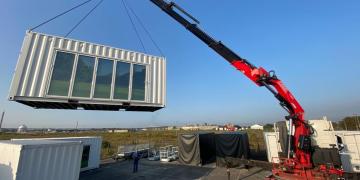Despite a lot of our customised container fleet predominately being rental, each year we undertake a large number of client custom-build shipping container projects, both for long term strategies and short term activations. A lot of our clients come to us with a relatively open brief but with some clear, practical requirements.

So, if you are looking at starting a custom-build shipping container conversion project, where do you start? We thought it might be useful to share some hints and tips based on our extensive experience.
1. Container Sizes
Many people know that containers come in various sizes, but few people know all the different configurations. The basic formats are 10ft, 20ft, 30ft and 40ft in length, but you can also get 44ft. All containers are 8ft wide and they come in standard height at 8ft 6” and High Cube at 9’ 6”.
The right size container, or indeed multiple container clusters, will depend on your brief. There are several important factors to consider, such as the transporting of the containers.
Building in High Cubes gives you a more open container space but it makes the logistics more difficult (particularly, outside the UK), and also makes stacking multiple containers more challenging due to building code stair regulations.
2. Container Configurations
Containers come in a variety of container configurations as well as differing sizes. There are containers with cargo doors on one end, both ends, 50%/50% split side doors and 75%/25% side doors. The various options also come with differing floor depths, making the right choice is critical to your accessibility.
3. Donor Containers
Starting with the best donor container is important to giving your build the best interior and exterior finish, as well as maximising the lifespan of your container build.
Containers are fabricated in the far east and either used long term for shipping or sold after a single journey to Europe. Using a single-use container is critical to giving you’re the best finish possible. The more journeys the container has completed, the more dents and damage the corrugation will have suffered. Likewise, prolonged sea use and paintwork damage start the process of corrosion, which whilst no problem for long-term cargo use, is a problem for container builds.
Container corrosion means that even after painting, signs of rust can still appear. As such using an older container will be a false economy.
4. Paintwork
Most container conversions tend to be painted with a custom colour finish which is where cost can be saved or increased based on the life expectancy of your container conversion.
A basic repaint, with multiple coats, will give you a nice finish, however with prolonged outdoor exposure, this can begin to fade and peel. As such, if a very long terms deployment is being considered, a more expensive two-pack paint finish may be worth considering.
5. Power and Electrics
The level of power required to power our conversion projects can vary enormously. Many clients just want some basic power for lighting, devices, screens and media drive. This can easily be delivered using a simple 16amp or 32amp single phase cee form input and mainboard.
However, we have also built complex structures, with cooking and heating devices which means power consumption can rise dramatically, meaning 32 amp three-phase input and even 63amp and 125 amp cee form and rotary power inputs can be needed.
Getting the best solution from the outset is critical, so to ensure the right power supply, you must know what devices you will run and what the likely consumption of these is.
6. Branding
Many clients want their container conversion to deliver a strong branding statement. The big sides can be a powerful graphic canvas when branded correctly. However, careful consideration of the design and application is important. The corrugation of a container needs to be factored into your design, as such, intricate detailing tends not to work as much.

In some instances, clients even want to clad the exterior with flat panels top give a flat surface for graphics. For our client build project for IMP on behalf of Yorkshire Water we did a full clad of the container to remove the corrugation look. It a simple decision over the importance of getting a true graphic's appearance from all angles vs the amended look.
At The Events Structure, we have a wide range of customised containers and pop-up units to help support your retail operations. All temporary pop-up structures are cost-effective, fully customisable and can be dispatched for both short- and long-term use immediately. For more information, contact the team on 0161 821 1010 today.


